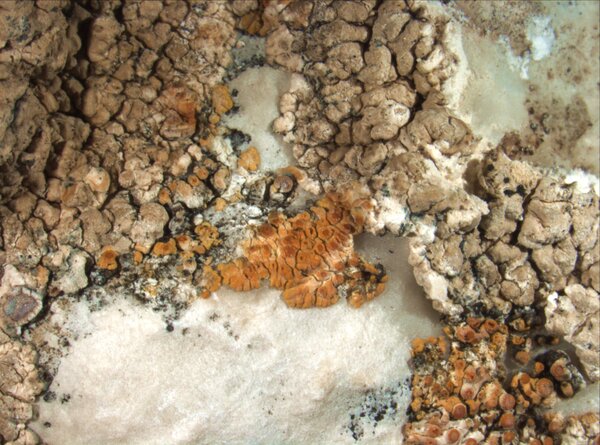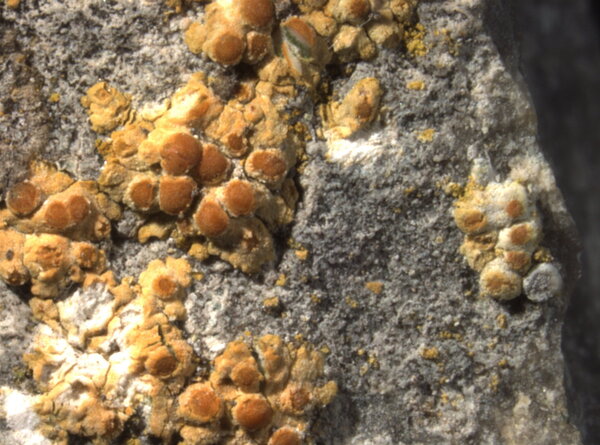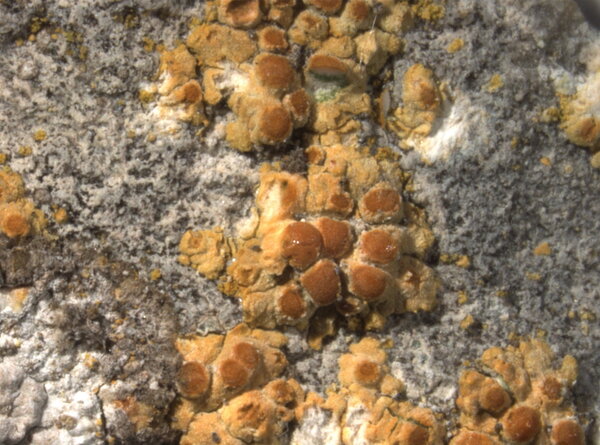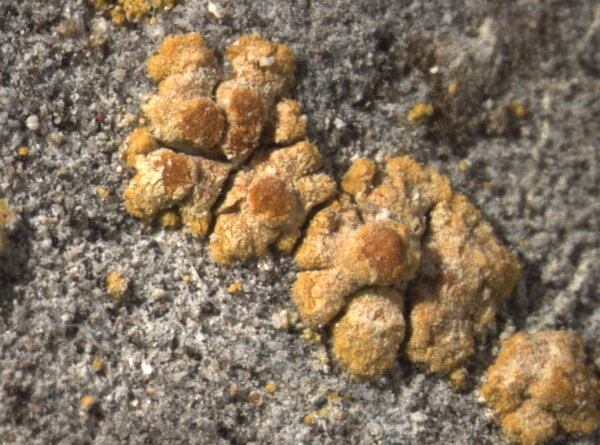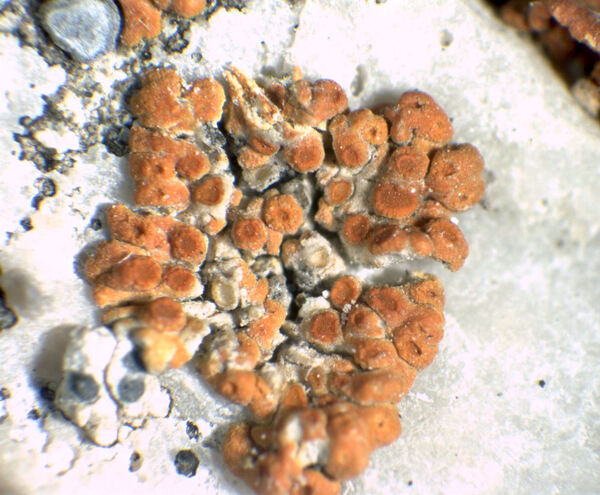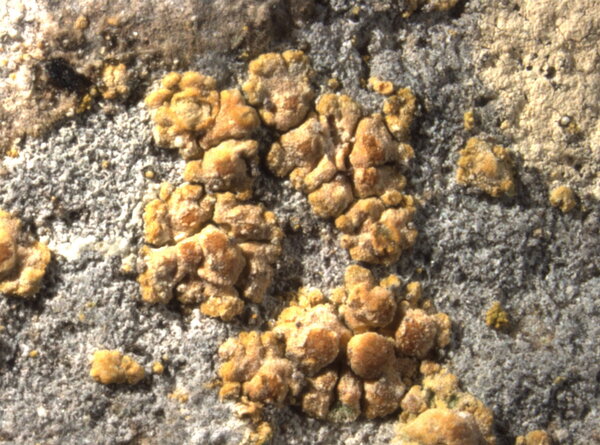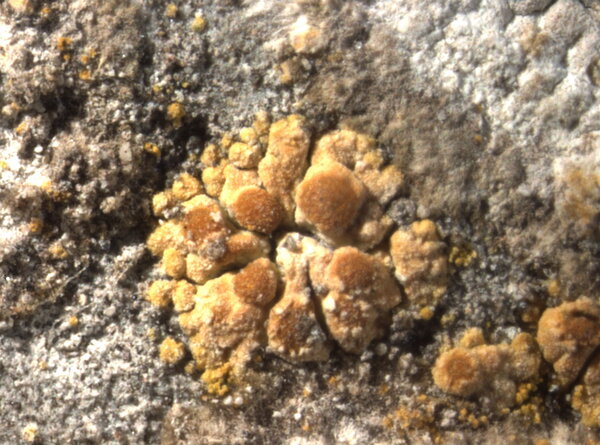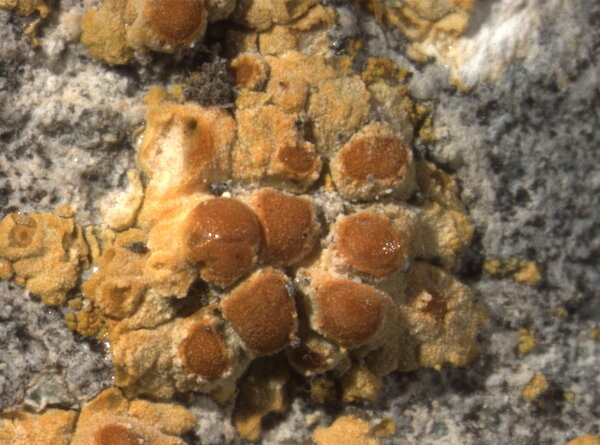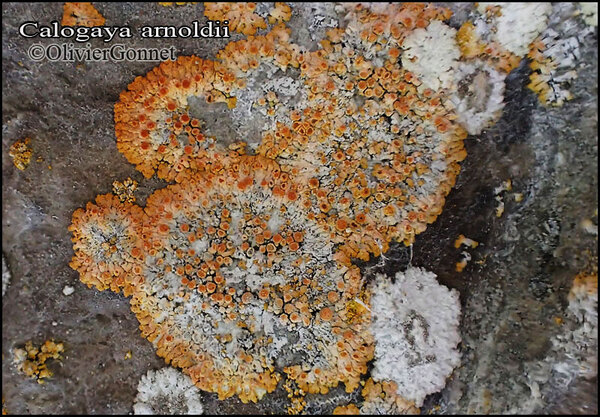Calogaya arnoldii (Wedd.) Arup, Frödén & Søchting
in Arup & al., Nord. J. Bot., 31: 38, 2013. Basionym: Lecanora arnoldii Wedd. - Bull. Soc. Bot. France, 23: 96, 1876.
Synonyms: Amphiloma murorum var. gyalolechioides auct. ital. p.p.; Calogaya arnoldii (Wedd.) Arup, Frödén & Søchting subsp. arnoldii; Caloplaca arnoldii (Wedd.) Zahlbr. ex Ginzb. non auct.ital.; Caloplaca biatorina subsp. gyalolechioides auct. p.p.; Caloplaca biatorinoides (Clauzade & Cl. Roux) Gaya, Nav.-Ros. & Cl. Roux; Caloplaca saxicola subsp. arnoldii (Wedd.) Clauzade & Cl. Roux non auct.ital.; Caloplaca saxicola subsp. biatorinoides Clauzade & Cl. Roux; Physcia pusilla var. lobulata f. minor Arnold; Placodium murorum f. arnoldii (Wedd.) A.L. Sm.
Distribution: N - VG, Ven, TAA (Nascimbene & al. 2021, 2022). C - Tosc (TSB 34239), Umb (Ravera & al. 2006). Mol (Genovesi & Ravera 2014), Sar.
Description: Thallus crustose-placodioid, episubstratic, forming orbicular, up to 1 cm wide rosettes, yellow-orange to orange (more yellow in shade-forms), usually abundantly pruinose. Central part of thallus with 0.3-1.3 mm wide, strongly convex, irregular to elongate areoles formed by lobe fragmentation; marginal lobes convex, irregular or finger-like, slightly broadening at tips, with short and often forked terminal branches, 0.1-1(-1.5) mm long, 0.1-0.6(-0.9) mm wide. Upper cortex with a 6-18.5(-22.5) μm thick, brownish-orange upper layer, and a hyaline (6-)10-45(-50) μm thick lower layer of irregularly arranged hyphae; medulla lax. Apothecia common, pseudolecanorine, more or less crowded, 0.3-0.7(-0.9) mm across, round or slightly deformed by mutual compression, located either on the areoles or on the lobe bases, sessile to constricted at base, the disk flat to strongly convex, concave in young apothecia, reddish-orange to brownish, somewhat pruinose, smooth, the margin paler than disk, without differentiation between proper and thalline margin, slightly pruinose, smooth, 25-100 μm. Epithecium 6-12 μm thick, brownish-orange K+ purple-red; hymenium, subhymenium and hypothecium colourless; paraphyses distinctly septate, forked or subapically branched, often anastomosing, (1.2-)1.5-3.5(-4) μm thick at base, the apical cells (2.5-)3.5-7.5(-8) μm wide. Asci 8-spored, clavate, functionally unitunicate, apically thickened with a broad internal beak, the inner part of apex and external cap I+ blue, Teloschistes-type. Ascospores 2-celled, polarilocular, hyaline, narrowly ellipsoid, (7.5-)9.5-13(-15) x (3.5-)4.5-5.5(-6.5) μm, the equatorial thickening (“septum”) (2-)3-4.5(-5) μm, > 1/3 of spore length. Photobiont chlorococcoid. Spot tests: thallus and apothecia K+ purple-red, C-, KC-, P-. Chemistry: thallus and apothecia with parietin (major), fallacinal, emodin, teloschistin and parietinic acid (minor), correponding with chemosyndrome A of Søchting (1997).Note: a well-distinct taxon of the extremely critical C. saxicola-complex, found on steeply inclined surfaces of calciferous rocks (limestone, dolomite, calcareous schists) in open habitats; certainly more widespread in Italy. For further details see Gaya & al. (2001).
Growth form: Crustose placodiomorph
Substrata: rocks
Photobiont: green algae other than Trentepohlia
Reproductive strategy: mainly sexual
In underhangs rarely wetted by rain
Commonnes-rarity: (info)
Alpine belt: absent
Subalpine belt: rare
Oromediterranean belt: very rare
Montane belt: very rare
Submediterranean belt: rather rare
Padanian area: absent
Humid submediterranean belt: rather rare
Humid mediterranean belt: absent
Dry mediterranean belt: absent
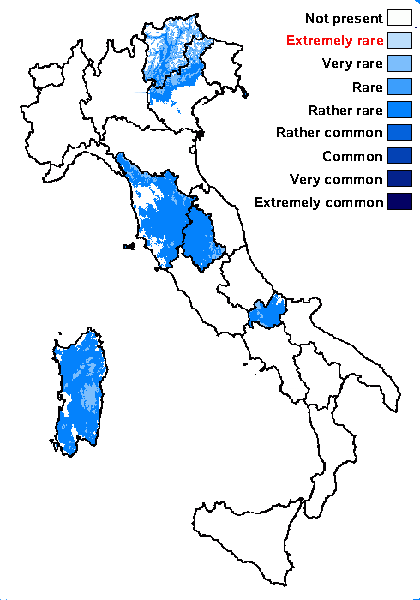
Predictive model
Herbarium samples

Bernard Bouffinier - Source: http://www.lichensmaritimes.org/index.php?task=fiche&lichen=1067&lang=en
France, Narbonne Abbaye de Fontfroide

Courtesy: Olivier et Danièle Gonnet - Source: https://www.afl-lichenologie.fr/Photos_AFL/Photos_AFL_C/Textes_C4/Calogaya_arnoldii.htm
France, session AFL 2015 dans le Lot, Blanzaguet
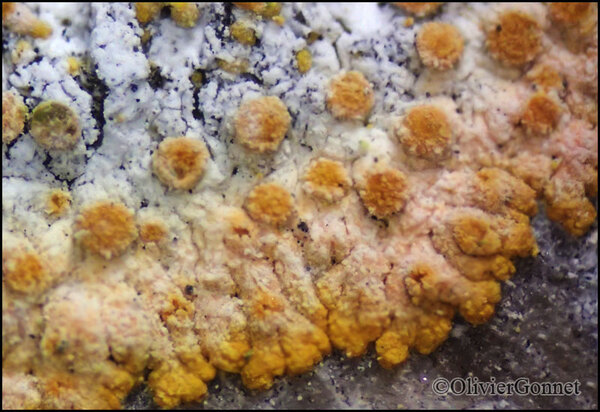
Courtesy: Olivier et Danièle Gonnet - Source: https://www.afl-lichenologie.fr/Photos_AFL/Photos_AFL_C/Textes_C4/Calogaya_arnoldii.htm
France, session AFL 2015 dans le Lot, Blanzaguet
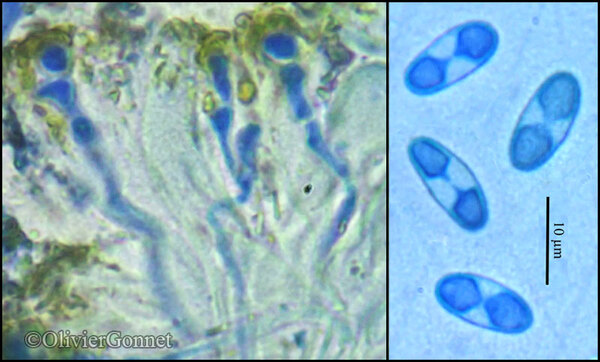
Courtesy: Olivier et Danièle Gonnet - Source: https://www.afl-lichenologie.fr/Photos_AFL/Photos_AFL_C/Textes_C4/Calogaya_arnoldii.htm
France, session AFL 2015 dans le Lot, Blanzaguet
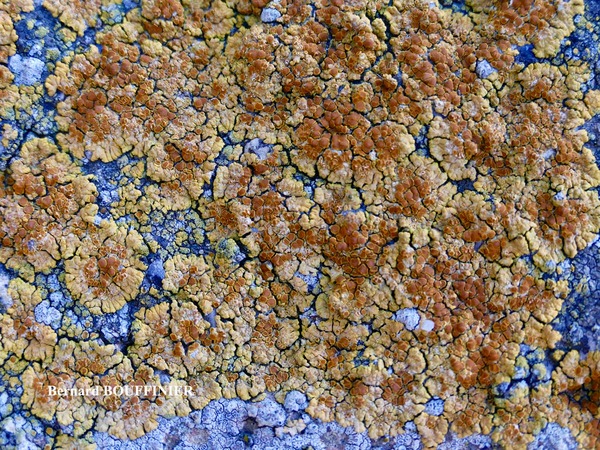
Bernard Bouffinier - Source: http://www.lichensmaritimes.org/index.php?task=fiche&lichen=1067&lang=en
France, Narbonne Abbaye de Fontfroide
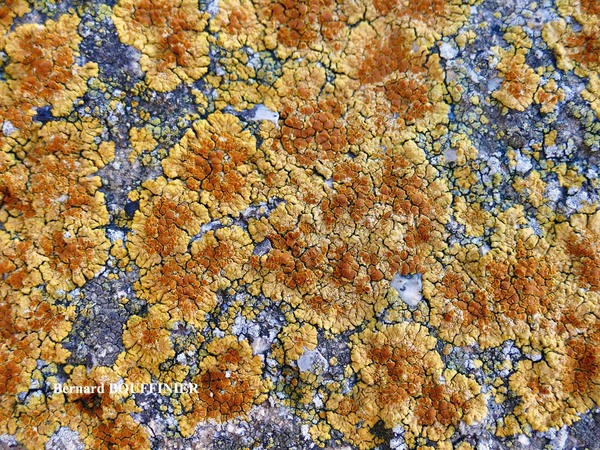
Bernard Bouffinier - Source: http://www.lichensmaritimes.org/index.php?task=fiche&lichen=1067&lang=en
France, Narbonne Abbaye de Fontfroide
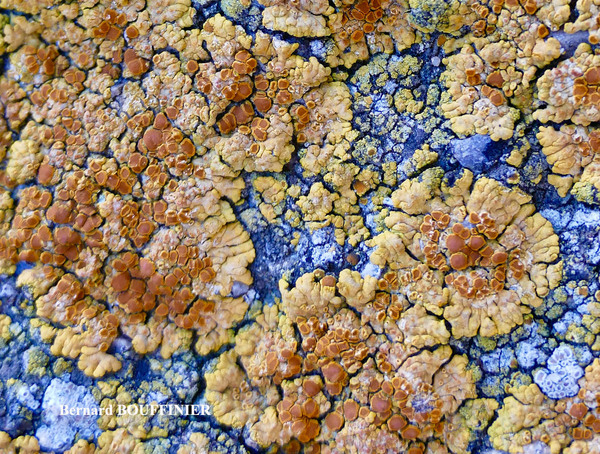
Bernard Bouffinier - Source: http://www.lichensmaritimes.org/index.php?task=fiche&lichen=1067&lang=en
France, Narbonne Abbaye de Fontfroide
Growth form: Crustose placodiomorph
Substrata: rocks
Photobiont: green algae other than Trentepohlia
Reproductive strategy: mainly sexual
In underhangs rarely wetted by rain
Commonnes-rarity: (info)
Alpine belt: absent
Subalpine belt: rare
Oromediterranean belt: very rare
Montane belt: very rare
Submediterranean belt: rather rare
Padanian area: absent
Humid submediterranean belt: rather rare
Humid mediterranean belt: absent
Dry mediterranean belt: absent

Predictive model
| Herbarium samples |

Bernard Bouffinier - Source: http://www.lichensmaritimes.org/index.php?task=fiche&lichen=1067&lang=en
France, Narbonne Abbaye de Fontfroide

Courtesy: Olivier et Danièle Gonnet - Source: https://www.afl-lichenologie.fr/Photos_AFL/Photos_AFL_C/Textes_C4/Calogaya_arnoldii.htm
France, session AFL 2015 dans le Lot, Blanzaguet

Courtesy: Olivier et Danièle Gonnet - Source: https://www.afl-lichenologie.fr/Photos_AFL/Photos_AFL_C/Textes_C4/Calogaya_arnoldii.htm
France, session AFL 2015 dans le Lot, Blanzaguet

Courtesy: Olivier et Danièle Gonnet - Source: https://www.afl-lichenologie.fr/Photos_AFL/Photos_AFL_C/Textes_C4/Calogaya_arnoldii.htm
France, session AFL 2015 dans le Lot, Blanzaguet

Bernard Bouffinier - Source: http://www.lichensmaritimes.org/index.php?task=fiche&lichen=1067&lang=en
France, Narbonne Abbaye de Fontfroide

Bernard Bouffinier - Source: http://www.lichensmaritimes.org/index.php?task=fiche&lichen=1067&lang=en
France, Narbonne Abbaye de Fontfroide

 DOLICHENS
DOLICHENS
